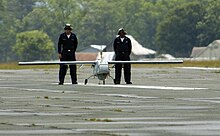
The Northrop Grumman RQ-4 Global Hawk is a high-altitude, remotely-piloted surveillance aircraft of the 1990s–2020s. It was initially designed by Ryan Aeronautical, and known as Tier II+ during development. The RQ-4 provides a broad overview and systematic surveillance using high-resolution synthetic aperture radar (SAR) and electro-optical/infrared (EO/IR) sensors with long loiter times over target areas. It can survey as much as 40,000 square miles (100,000 km2) of terrain per day, an area the size of South Korea or Iceland.

The AAI RQ-7 Shadow is an American unmanned aerial vehicle (UAV) used by the United States Army, Australian Army, Swedish Army, Turkish Air Force and Italian Army for reconnaissance, surveillance, target acquisition and battle damage assessment. Launched from a trailer-mounted pneumatic catapult, it is recovered with the aid of arresting gear similar to jets on an aircraft carrier. Its gimbal-mounted, digitally stabilized, liquid nitrogen-cooled electro-optical/infrared (EO/IR) camera relays video in real time via a C-band line-of-sight data link to the ground control station (GCS).

The Alliant RQ-6 Outrider unmanned aerial vehicle (UAV) was designed to provide near-real-time reconnaissance, surveillance, and target acquisition information to United States Marine Corps air/ground task forces, United States Army brigades, and deployed United States Navy units that was small enough for an entire system to be contained on two Humvees and trailer and transported on a single C-130 Hercules cargo aircraft.

AAI Corporation is an aerospace and defense development and manufacturing firm, located in Hunt Valley, Maryland, US. Formerly a wholly owned subsidiary of United Industrial Corporation, AAI was acquired by Textron in 2007. It currently operates as a unit of Textron Systems and employs more than 2,000.

UAVs include both autonomous drones and remotely piloted vehicles (RPVs). A UAV is capable of controlled, sustained level flight and is powered by a jet, reciprocating, or electric engine. In the twenty first century technology reached a point of sophistication that the UAV is now being given a greatly expanded role in many areas of aviation.
The usefulness of UAVs for aerial reconnaissance was demonstrated to the United States in the Vietnam War. At the same time, early steps were being taken to use them in active combat at sea and on land, but unmanned combat aerial vehicles would not come into their own until the 1980s.
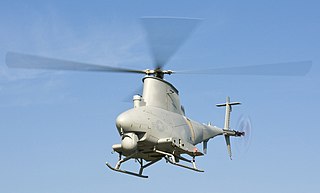
The Northrop Grumman MQ-8 Fire Scout is an unmanned autonomous helicopter developed by Northrop Grumman for use by the United States Armed Forces. The Fire Scout is designed to provide reconnaissance, situational awareness, aerial fire support and precision targeting support for ground, air and sea forces. The initial RQ-8A version was based on the Schweizer 330, while the enhanced MQ-8B was derived from the Schweizer 333. The larger MQ-8C Fire Scout variant is based on the Bell 407.

Marine Unmanned Aerial Vehicle Squadron 1 (VMU-1) is an unmanned aerial vehicle squadron in the United States Marine Corps that operates the MQ-9A Reaper. They are based out of Marine Corps Air Station Yuma, Arizona and provide reconnaissance, surveillance, and target acquisition for the I Marine Expeditionary Force. They fall under the command of Marine Aircraft Group 13 and the 3rd Marine Aircraft Wing.
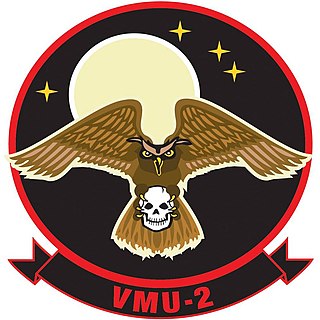
Marine Unmanned Aerial Vehicle Squadron 2 (VMU-2) is an unmanned aerial vehicle squadron in the United States Marine Corps that operates the RQ-21A Blackjack. The squadron is based at Marine Corps Air Station Cherry Point in Havelock, North Carolina and provides aerial surveillance, offensive air support, and electronic warfare for the II Marine Expeditionary Force. VMU-2 falls under the command of Marine Aircraft Group 14 and the 2nd Marine Aircraft Wing.
The U.S. Department of Defense (DoD) employs Unmanned Aerial Systems (UAS) across all echelons to support tactical, operational, and strategic operations. The types of UAS that are used in these operations are categorized into "Groups" according to their size and capability. Previous to 2010, UAS were categorized into "Tiers" or "Classes" separately by each branch of the military. In order to promote a homogeneous categorization, the "group system" was developed.

The IAI Scout is a reconnaissance unmanned air vehicle developed in Israel in the 1970s by Israel Aircraft Industries as a competitor to the Tadiran Mastiff. The project was led by Charley Attali, David Harari, and Michael Shefer who were all awarded the 1981 Israel Defense Prize.
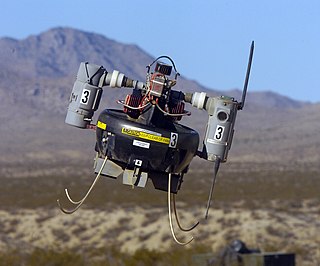
The Honeywell RQ-16A T-Hawk is a ducted fan VTOL miniature UAV. Developed by Honeywell, it is suitable for backpack deployment and single-person operation.
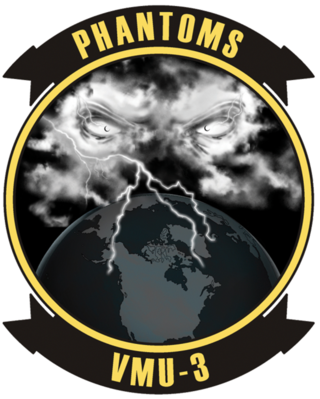
Marine Unmanned Aerial Vehicle Squadron 3 is an unmanned aerial vehicle (UAV) squadron in the United States Marine Corps that operates the RQ-21 Blackjack that consists of approximately 200 Marines. They are based out of Marine Corps Base Hawaii, Kaneohe Bay, Hawaii and its primary mission is to provide aerial surveillance for the III Marine Expeditionary Force. The unit also provides Reconnaissance, Surveillance, and Target Acquisition (RSTA) to units participating in Mojave Viper, an exercise held several times a year in 29 Palms, CA. The squadron, nicknamed the Phantoms, was activated on September 12, 2008 and falls under the command of Marine Aircraft Group 24 and the 1st Marine Aircraft Wing.

The AeroVironment Wasp III Small Unmanned Aircraft System is a miniature UAV developed for United States Air Force special operations to provide a small, light-weight vehicle to provide beyond-line-of-sight situation awareness. The aircraft is equipped with two on-board cameras to provide real-time intelligence to its operators. It is also equipped with GPS and an Inertial Navigation System enabling it to operate autonomously from takeoff to recovery. It was designed by AeroVironment Inc., and was first added to the Air Force inventory in 2007. There are two Wasp variants: the traditional version that lands on land, and a version that lands into the sea or fresh water. The Air Force accepted the Wasp AE in late May 2012, and the U.S. Marine Corps revealed in January 2013 that they had ordered the Wasp AE. The Wasp AE is designated as the RQ-12A.

The AeroVironment T-20 unmanned aerial vehicle (UAV) is a medium range, composite aircraft capable of internal and external payloads. Launched from a portable catapult, it can be recovered with a shipboard landing system, or belly land on unimproved surfaces. The T-20 carries a retractable gimbal-mounted, digitally stabilized, electro-optical/infrared (EO/IR) camera that relays video in real time via a C-band LOS data link to the ground control station (GCS). Powered by a 4-stroke, fuel injected gasoline engine, the aircraft burns 2 lb (910 g) of fuel per hour at cruise. AeroVironment, Inc. acquired Arcturus UAV, the original developer of JUMP 20 and T-20 on February 22, 2021.
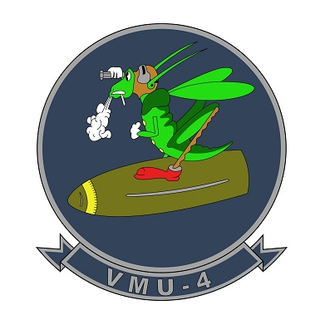
Marine Unmanned Aerial Vehicle Squadron 4 (VMU-4) is an unmanned aerial vehicle (UAV) squadron in the United States Marine Corps that operates the RQ-21 Blackjack. It is the fourth UAV squadron in the Marine Corps and the first in the reserve component. The squadron, nicknamed the "Evil Eyes", entered the force structure on 1 July 2010, when Marine Observation Squadron 4 (VMO-4) was reactivated and redesignated VMU-4.
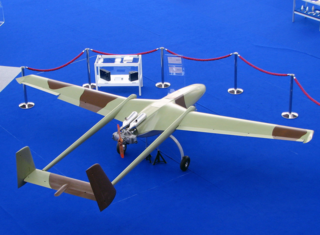
The PEGAZ 011 is a medium-range tactical UAV for day and night attack, reconnaissance and surveillance missions, target acquisition and designation developed by Military Technical Institute in Serbia and produced by Utva Aviation Industry, subsidiary of Yugoimport SDPR. Its flight autonomy is over 12 hours, and it sends data from the height of 6,000 m. Powered by a two-cylinder boxer type of engine with 32 kW (43 HP), it reaches the maximum flight speed of 200 km/h. The PEGAZ has a maximum weight of 240 kg, including about 50 kg of reconnaissance/surveillance equipment. It is 5.4 m long with a wingspan of 6.34 m. It takes off automatically from improvised runways and performs tasks along pre-programmed flight. There are two hardpoints for optional air-to-surface missiles for attack variant.

The AeroVironment RQ-20 Puma is an American unmanned aircraft system which is small, battery powered, and hand-launched. Its primary mission is surveillance and intelligence gathering using an electro-optical and infrared camera. It is produced by AeroVironment.

The Boeing Insitu RQ-21 Blackjack, company name Integrator, is an American unmanned air vehicle designed and built by Boeing Insitu to meet a United States Navy requirement for a small tactical unmanned air system (STUAS). It is a twin-boom, single-engine monoplane, designed as a supplement to the Boeing Scan Eagle. The Integrator weighs 61 kg (134 lb) and uses the same launcher and recovery system as the Scan Eagle.

